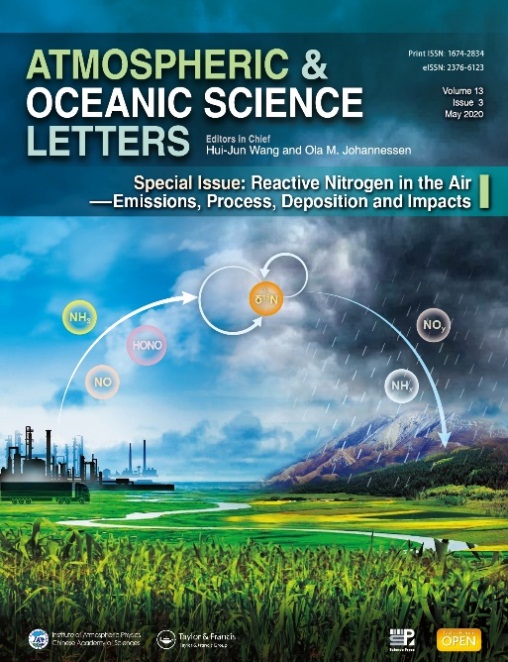中国科学院大气物理研究所主办国际期刊Atmospheric and Oceanic Science Letters (AOSL)推出了“Special Issue on Reactive Nitrogen in the Air: Emissions, Process, Deposition, and Impacts”(以下简称“大气活性氮专刊”),于2020年5月21日在Taylor & Francis 上线(https://www.tandfonline.com/toc/taos20/13/3)。”大气活性氮专刊”由AOSL编委、中国科学院大气物理研究所研究员潘月鹏领衔组织,经严格的同行评议,刊登了来自中科院大气物理所、烟台海岸带所、亚热带生态所、成都山地所、国家气象局卫星中心、南京大学、南京信息工程大学、南京师范大学、华东师范大学、暨南大学和中山大学等高等院校和科研机构的13篇稿件。

(“大气活性氮专刊”封面)
”大气活性氮专刊”覆盖了4个主要研究领域,包括气态氮排放、含氮物质的大气输送、氮沉降格局和溯源、大气活性氮效应和减排策略。
作为全球氨排放最高的国家,中国氨排放及其影响备受关注。基于自下而上的清单估算方法,Huang等(2020)研究了我国氨排放热点区-江苏的氨排放变化,发现江苏农业氨排放经历了平稳(2000-2006)、迅速增加(2007-2012)、而后下降(2013-2017)的年际变化规律;农业源中养殖业排放占78.1%,而农业施肥氨挥发只占21.9%。这一排放构成在合肥地区高分辨率氨排放研究中也得到了证实(Hou and Yu, 2020)。此外,Hou and Yu (2020) 发现合肥农业源氨排放强度与农村居民点具有明显的关联性。除了农业源,自然源土壤也会释放氨等大量活性氮气体。Wu等 (2020) 针对多种土壤开展了实验室模拟,发现基于冷冻干燥土壤获得的活性氮气体排放特征与自然的新鲜土壤最为接近,而传统的自然风干或者烘箱干燥方法会显著增加气体排放量。
在传统农业源和自然源之外,生物质等燃烧源活性氮排放经常造成大气污染事件。Wang等 (2020) 基于2003-2017年期间的卫星资料,发现东北地区91%的火点发生在农田下垫面,且集中在春季和秋季。而在珠三角地区,Guo等(2020)观测发现秋季霾污染事件的主要诱因与生物质燃烧有关,他们还揭示了区域性的硝酸盐气溶胶污染及气象因素的影响。Zong等(2020)使用氮氧双同位素示踪技术,追踪了2015年天津港爆炸火灾事件引起的活性氮污染在渤海上空的传输与沉降,估算出该事件的影响范围占渤海面积的20%。Chang等(2020)基于鼎湖山降水观测资料和后向轨迹模型,发现富营养化区域的海水有机氮被台风携带着返回陆地,是珠三角森林降水氮沉降的主要形态。
在氮沉降定量技术方面,传统方法主要使用雨量筒进行样品收集。Chen等(2020)发现野生苔藓氮含量与氮的湿沉降量线性相关,为利用苔藓监测氮沉降提供了佐证;他们还测量了苔藓的氮同位素组成,并成功追踪到了湿沉降中氮的来源。此外,卫星遥感技术的发展增进了科学界对区域氮沉降的认识。Wang等(2020)基于卫星资料和大气化学传输模式明确了华北氮沉降主要以气体干沉降为主,特别是氨气的贡献较大。目前,大气氮沉降已经成为影响生态系统健康和气候变化的重要议题,但之前有关氮沉降效应的评估主要基于喷水施肥实验。Pan等(2020)提出未来的氮沉降效应研究应进一步考虑氨气干沉降,以全面评估全球氨气浓度增加对生态环境造成的潜在影响。
为缓解大气污染,我国正在实施减排行动计划,这一措施对大气活性氮化学也产生了重要影响。Xu等 (2020)发现,由于二氧化硫的大幅消减,大气细颗粒物的形成过程对于氮氧化物的敏感性在增加,而对氨气的敏感性在下降,间接反映出大气氨过量。在消减氨排放源的基础上,增汇同样也可以减少大气氨。Yi等(2020)通过实地测量,发现稻田挥发的氨气只有20%进入了大气,剩余的80%沉降在周边100米范围内丘陵山地,因而增加绿地(如植树)可以增加氨气的汇。此外,Zhang等(2020)发现,秸秆还田能够增加石灰性土壤肥力,还可以减少氨排放,是值得推广的减排方案。
“大气活性氮专刊”收录的13篇论文跨越了大气科学、环境科学和生态学等多学科交叉研究领域,为广大学者理解大气活性氮的源汇过程提供了全新的视角。
“大气活性氮专刊”引文信息如下:
Chang, M., W. Chen, S. Deng, X. Wang, and S. Zhou, 2020: "Are typhoon and marine eutrophication the possible missing sources of high dissolved organic nitrogen in wet deposition?", Atmospheric and Oceanic Science Letters, 13(3), 182–187. https://doi.org/10.1080/16742834.2019.1679016.
Chen, Z., T. Huang, R. Fan, H. Yang, Y. Yang, and C. Huang, 2020: "Atmospheric nitrogen deposition in Yangtze River Delta: insights gained from the nitrogen content and isotopic composition of the moss Haplocladium microphyllum." Atmospheric and Oceanic Science Letters, 13(3), 202–209. https://doi.org/10.1080/16742834.2019.1688629.
Guo, J., S. Zhou, X. Sun, M. Huang, H. Dong, M. Chang, Q. Fan, S. Fan, and X. Wang, 2020: "The regional nature of nitrate-dominant haze pollution during autumn over the Pearl River Delta area." Atmospheric and Oceanic Science Letters, 13(3), 252–259. https://doi.org/10.1080/16742834.2020.1740055.
Hou, X. and X. Yu, 2020: "An ammonia emissions inventory for agricultural sources in Hefei, China ", Atmospheric and Oceanic Science Letters, 13(3), 260–267. https://doi.org/10.1080/16742834.2020.1747355.
Huang, J., R. Xiong, L. Fang, T. Li, and W. Shen, 2020: "Estimation of interannual trends of ammonia emissions from agriculture in Jiangsu Province from 2000 to 2017." Atmospheric and Oceanic Science Letters, 13(3), 268–273. https://doi.org/10.1080/16742834.2020.1736499.
Pan, Y., S. Tian, D. Wu, W. Xu, X. Zhu, C. Liu, D. Li, Y. Fang, L. Duan, X. Liu, and Y. Wang, 2020: "Ammonia should be considered in field experiments mimicking nitrogen deposition." Atmospheric and Oceanic Science Letters, 13(3), 248–251. https://doi.org/10.1080/16742834.2020.1733919.
Wang, L., X. Jin, Q. Wang, H. Mao, Q. Liu, G. Weng, and Y. Wang, 2020: "Spatial and temporal variability of open biomass burning in Northeast China from 2003 to 2017." Atmospheric and Oceanic Science Letters, 13(3), 240–247. https://doi.org/10.1080/16742834.2020.1742574.
Wang, Z., X. Zhang, L. Liu, M. Cheng, and J. Xu, 2020: "Spatial and seasonal patterns of atmospheric nitrogen deposition in North China." Atmospheric and Oceanic Science Letters, 13(3), 188–194. https://doi.org/10.1080/16742834.2019.1701385.
Wu, D., L. Deng, Y. Liu, D. Xi, H. Zou, R. Wang, Z. Sha, Y. Pan, L. Hou, and M. Liu, 2020: "Comparisons of the effects of different drying methods on soil nitrogen fractions: Insights into emissions of reactive nitrogen gases (HONO and NO)." Atmospheric and Oceanic Science Letters, 13(3), 224–231. https://doi.org/10.1080/16742834.2020.1733388.
Xu, G., Q. Zang, Y. Yao, and X. Zhang, 2020: "Changes in PM2.5 sensitivity to NOx and NH3 emissions due to a large decrease in SO2 emissions from 2013 to 2018." Atmospheric and Oceanic Science Letters, 13(3), 210–215. https://doi.org/10.1080/16742834.2020.1738009.
Yi, Y., J. Shen, C. Yang, J. Wang, Y. Li, and J. Wu, 2020: "Dry deposition of ammonia around paddy fields in the subtropical hilly area in southern China." Atmospheric and Oceanic Science Letters, 13(3), 216–223. https://doi.org/10.1080/16742834.2020.1738208.
Zhang, B., M. Zhou, H. Lin, N. Tite, Y. Wang, and B. Zhu, 2020: "Effects of different long-term crop straw management practices on ammonia volatilization from subtropical calcareous agricultural soil." Atmospheric and Oceanic Science Letters, 13(3), 232–239. https://doi.org/10.1080/16742834.2020.1736498.
Zong, Z., Z. Sun, Y. Tan, C. Tian, L. Qu, and L. Ji, 2020: "Impact of an accidental explosion in Tianjin Port on enhanced atmospheric nitrogen deposition over the Bohai Sea inferred from aerosol nitrate dual isotopes." Atmospheric and Oceanic Science Letters, 13(3), 195–201. https://doi.org/10.1080/16742834.2019.1682926.






